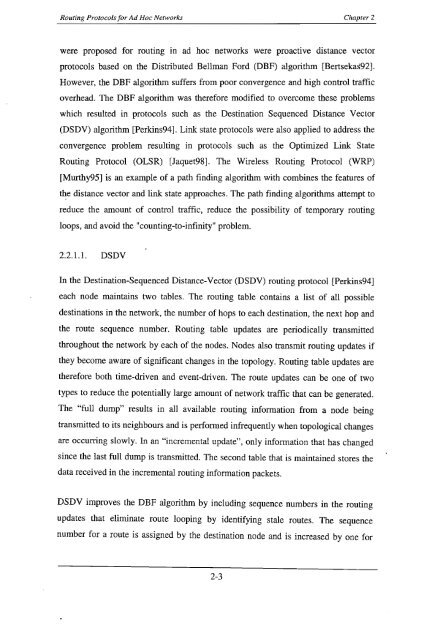Gugrajah_Yuvaan_ Ramesh_2003.pdf
Gugrajah_Yuvaan_ Ramesh_2003.pdf
Gugrajah_Yuvaan_ Ramesh_2003.pdf
Create successful ePaper yourself
Turn your PDF publications into a flip-book with our unique Google optimized e-Paper software.
Routing Protocols for Ad Hoc Networks Chapter 2<br />
were proposed for routing in ad hoc networks were proactive distance vector<br />
protocols based on the Distributed Bellman Ford (DBF) algorithm [Bertsekas92].<br />
However, the DBF algorithm suffers from poor convergence and high control traffic<br />
overhead. The DBF algorithm was therefore modified to overcome these problems<br />
which resulted in protocols such as the Destination Sequenced Distance Vector<br />
(DSDV) algorithm [Perkins94]. Link state protocols were also applied to address the<br />
convergence problem resulting in protocols such as the Optimized Link State<br />
Routing Protocol (OLSR) [Jaquet98]. The Wireless Routing Protocol (WRP)<br />
[Murthy95] is an example of a path finding algorithm with combines the features of<br />
the distance vector and link state approaches. The path finding algorithms attempt to<br />
reduce the amount of control traffic, reduce the possibility of temporary routing<br />
loops, and avoid the "counting-to-infinity" problem.<br />
2.2.1.1. DSDV<br />
In the Destination-Sequenced Distance-Vector (DSDV) routing protocol [Perkins94]<br />
each node maintains two tables. The routing table contains a list of all possible<br />
destinations in the network, the number of hops to each destination, the next hop and<br />
the route sequence number. Routing table updates are periodically transmitted<br />
throughout the network by each of the nodes. Nodes also transmit routing updates if<br />
they become aware of significant changes in the topology. Routing table updates are<br />
therefore both time-driven and event-driven. The route updates can be one of two<br />
types to reduce the potentially large amount of network traffic that can be generated.<br />
The "full dump" results in all available routing information from a node being<br />
transmitted to its neighbours and is performed infrequently when topological changes<br />
are occurring slowly. In an "incremental update", only information that has changed<br />
since the last full dump is transmitted. The second table that is maintained stores the<br />
data received in the incremental routing information packets.<br />
DSDV improves the DBF algorithm by including sequence numbers in the routing<br />
updates that eliminate route looping by identifying stale routes. The sequence<br />
number for a route is assigned by the destination node and is increased by one for<br />
2-3
















